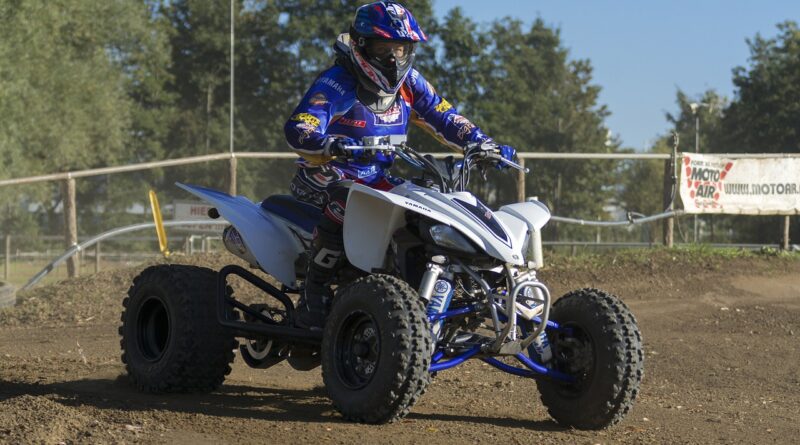2009-2010 Yamaha YFZ450R (YFZ450-R) Won’t Start
The title “Yamaha YFZ4504 Won’t Start” refers to a situation in which the engine of a Yamaha YFZ450R (YFZ450RY) ATV fails to activate and turn on, preventing the vehicle from starting. This issue indicates a disruption in the engine’s normal operation, often involving the fuel system and/or the electrical system. Symptoms of this problem may include the engine failing to crank, a clicking noise when attempting to start, or the engine attempting to turn over but not successfully starting. The cause of this concern could range from a malfunctioning fuel pump or clogged fuel filter within the fuel system, to issues within the electrical system such as a dead battery, faulty starter solenoid, or damaged ignition components. Addressing these potential problems is essential to rectify the situation and cause the engine to begin working again, enabling the Yamaha YFZ450R to start and run as intended.
This troubleshooting guide is intended to serve as a fundamental aid for diagnosing problems. It does not cover all possible causes of trouble but offers valuable insights into basic troubleshooting procedures that can aid in identifying and resolving various concerns.
Fuel System
1. Fuel Tank
- Empty Fuel Tank: It might sound obvious, but an empty fuel tank is the simplest explanation for a YFZ450’s refusal to start. Always ensure that you have an adequate amount of fuel before delving deeper into the issue.
- Clogged Fuel Filter: The fuel filter prevents debris from reaching the engine, but over time, it can become clogged with dirt and contaminants. A clogged fuel filter restricts the fuel flow, impeding the engine’s ability to start.
- Clogged Fuel Tank Breather Hose: The fuel tank breather hose ensures proper air circulation within the tank as fuel is used. If this hose becomes clogged, it can create a vacuum within the tank, obstructing fuel flow to the engine.
- Clogged Rollover Valve: The rollover valve is designed to prevent fuel leakage in case of a rollover or accident. However, if this valve becomes clogged, it can disrupt the fuel system’s balance and lead to starting issues.
- Deteriorated or Contaminated Fuel: Fuel quality is essential for proper engine performance. Old, deteriorated, or contaminated fuel can cause starting problems, as it may not ignite efficiently or could contain impurities that affect engine operation.
2. Fuel Pump
- Faulty Fuel Pump: A malfunctioning fuel pump can result in inadequate fuel delivery to the engine, causing it to struggle or fail to start altogether.
- Faulty Fuel Pump Relay: The fuel pump relay controls the electrical current to the fuel pump. If this relay is faulty, the fuel pump might not receive the necessary power, leading to starting issues.
3. Throttle Body
- Deteriorated or Contaminated Fuel: Just as poor fuel quality can affect the fuel tank, it can also impact the throttle body, leading to clogs or poor fuel atomization that hampers engine ignition.
- Sucked-In Air: If there are air leaks around the throttle body or its connections, the engine might draw in extra air, upsetting the fuel-to-air ratio and making starting difficult.
Engine
1. Cylinder and Cylinder Head
- Loose Spark Plug: A spark plug that’s not securely tightened can cause weak or absent ignition, hindering the engine’s ability to start.
- Loose Cylinder Head or Cylinder: If the cylinder head or cylinder isn’t properly secured, it can result in poor compression, leading to starting difficulties.
- Damaged Cylinder Head Gasket: A damaged gasket can result in compression loss, allowing gases to escape and preventing the engine from firing up.
- Damaged Cylinder Gasket: Similar to the head gasket, a damaged cylinder gasket can lead to compression problems and hinder proper engine start-up.
- Worn or Damaged Cylinder: A worn or damaged cylinder can compromise compression, affecting engine performance and starting.
- Incorrect Valve Clearance: Incorrect valve clearance can disrupt the combustion process, causing issues with engine start-up.
- Improperly Sealed Valve: A valve that isn’t properly sealed can result in compression leakage, making it difficult for the engine to start.
- Incorrect Valve-to-Valve-Seat Contact: If the valves aren’t making proper contact with their seats, compression can be affected, leading to starting troubles.
- Incorrect Valve Timing: Timing is critical for combustion. Incorrect valve timing can lead to misfires and difficulty in engine start-up.
- Faulty Valve Spring: A malfunctioning valve spring can disrupt the valve’s movement, affecting compression and engine start.
- Seized Valve: A valve that’s seized or stuck can prevent proper airflow and compression, making engine start-up a challenge.
2. Piston and Piston Rings
- Improperly Installed Piston Ring: If a piston ring is improperly installed, it can affect compression, resulting in starting issues.
- Damaged, Worn, or Fatigued Piston Ring: Rings in poor condition can’t seal the combustion chamber effectively, leading to compression loss and trouble starting.
- Seized Piston Ring: A seized piston ring can disrupt piston movement, affecting compression and engine performance.
- Seized or Damaged Piston: A seized or damaged piston can lead to poor compression, making engine start-up an uphill battle.
3. Air Filter
- Improperly Installed Air Filter: An air filter that’s not correctly installed can result in inadequate airflow, affecting combustion and engine start.
- Clogged Air Filter Element: A clogged air filter restricts airflow, leading to inefficient combustion and starting problems.
4. Crankcase and Crankshaft
- Improperly Assembled Crankcase: If the crankcase isn’t assembled correctly, it can lead to oil leaks, which can subsequently affect engine start-up.
- Seized Crankshaft: A crankshaft that’s seized or not rotating freely can prevent the engine from turning over, causing starting issues.
Electrical System
1. Battery
- Discharged Battery: A discharged battery is a common culprit. Insufficient power can hinder the engine’s ignition process.
- Faulty Battery: A battery that’s reached the end of its lifespan can struggle to provide the required voltage, affecting the starting process.
2. Fuse
- Blown, Damaged, or Incorrect Fuse: A blown fuse can interrupt the flow of electricity, effectively preventing the engine from starting.
- Improperly Installed Fuse: Incorrectly inserted fuses won’t make proper connections and can lead to starting issues.
3. Spark Plug
- Incorrect Spark Plug Gap: An incorrect gap can lead to weak or no sparks, affecting the ignition process.
- Incorrect Spark Plug Heat Range: The wrong heat range can result in misfires and starting problems.
- Fouled Spark Plug: A fouled plug covered in carbon deposits can fail to spark, hampering ignition.
- Worn or Damaged Electrode/Insulator: Damage to the spark plug’s electrode or insulator can cause weak or no sparks.
- Faulty Spark Plug Cap: A malfunctioning spark plug cap can disrupt the flow of electricity, leading to starting troubles.
4. Ignition Coil
- Cracked or Broken Ignition Coil Body: Physical damage to the coil can lead to electrical issues, affecting ignition.
- Broken or Shorted Coils: A broken or shorted primary or secondary coil can disrupt the spark generation process.
- Faulty Spark Plug Lead: A damaged spark plug lead can impede the flow of electricity, affecting ignition.
5. Ignition System
- Faulty ECU: A malfunctioning Engine Control Unit (ECU) can disrupt the engine’s ignition timing and cause starting problems.
- Faulty Crankshaft Position Sensor: This sensor provides critical timing information; a faulty one can hinder ignition.
- Broken Generator Rotor Woodruff Key: A damaged woodruff key can cause misalignment, leading to starting issues.
6. Switches and Wiring
- Faulty Main Switch: A malfunctioning main switch can interrupt the electrical circuit, affecting ignition.
- Faulty Engine Stop Switch: Similar to the main switch, a faulty stop switch can disrupt the electrical flow needed to start the engine.
- Broken or Shorted Wiring: Damaged or shorted wires can cause electrical interference, preventing proper ignition.
- Faulty Neutral/Start/Clutch Switches: Issues with these switches can prevent the engine from receiving the necessary signals to start.
- Improperly Grounded Circuit: Insufficient grounding can disrupt electrical flow, affecting starting.
- Loose Connections: Loose or corroded connections can hinder the transmission of electrical signals, leading to starting woes.
7. Starting System
- Faulty Starter Motor: A malfunctioning starter motor might not have the power to crank the engine effectively.
- Faulty Starter Relay: A defective starter relay can prevent the starter motor from receiving the necessary power to turn the engine.
- Faulty Starter Clutch: A problematic starter clutch can disrupt the engagement between the starter and the engine.
The article titled “Yamaha YFZ-450R Won’t Start” offers a comprehensive guide on addressing the common problem of engine non-engagement in Yamaha YFZ450R ATVs. This guide methodically examines potential issues in the fuel and electrical systems, including symptoms, causes, and solutions. From fuel blockages to electrical irregularities and complex engine problems, the article provides a complete troubleshooting framework, helping ATV owners diagnose and resolve various starting issues. The guide ensures the smooth activation of Yamaha YFZ450R ATVs, allowing uninterrupted and enjoyable off-road experiences.
References
Yamaha. (2009). YFZ450R Factory Service Manual. Section 9 – Troubleshooting, p. 378.




